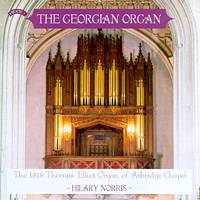
Rich and resonant
Hilary Norris plays the organ of Ashridge Chapel, reviewed by JULIA IONIDES
Priory PRCD 741
|

|
In my childhood we lived near Berkhamsted and I walked and rode my pony in the woods at Ashridge. I watched the filming of The Knights of the Round Table in the same woods and got an autograph from a genial and charming Mel Ferrer and a refusal from a grumpy Robert Taylor. And I had no idea that Ashridge Chapel housed this remarkable organ
[listen -- track 1, 0:02-0:54].
Since then, an MA and one book later, I have became passionate about the Georgian period and that passion extends to all spheres of Georgian life and culture, including music. So I was very pleased to be asked to review this Priory CD of the Georgian Organ; however I must make it clear that my knowledge of music is from a listener's point of view and not a player's.
The organ is housed in the splendid setting of the chapel, completed in 1816; the Gothic Revival house itself was started in 1808 by James Wyatt for the Seventh Earl of Bridgewater. The organ was installed there in 1818 by Thomas Elliot of Tottenham Court but much of the work was done by his apprentice, William Hill, later to become a distinguished builder of organs himself.
This all may sound irrelevant to the review, but this setting and the organ's origins do produce a wonderful, rich resonant sound. Fortunately proposals to modernise it were never carried out and so what we hear today is the voice of the original organ. It has been awarded an Historic Organ Certificate of the British Institute of Organ Studies.
Now to the music played. Many Georgian organists held posts in churches, as well as writing for the theatre and other forms of entertainments; this shows in the invention of the compositions and also in the opportunity for the player to improvise, thus showing off their skills. The influence of Handel can be heard through much of the music, especially in the first two pieces which are from Concertos, a form invented by Handel as interludes between acts in performances of his oratorios.
The composers on this CD range from Thomas Arne, born in 1710 to Thomas Adams born in 1785, so the time span is wide. When Arne was writing the influence of Handel, as well as the rococo and baroque styles, would have been strong; Arne, as a Roman Catholic did not have a church appointment and wrote successfully for the theatre and the London Pleasure Gardens. We need to keep in mind that this was the popular music of the day and perhaps not everyone liked it, just as many of us do not like 'pop' music today. We now admire the skill of the compositions and the interesting and pleasant sounds they produce, especially on an organ of this stature, but at the time they were written they were 'modern' and there was probably some Georgian 'tut-tutting'.
At the other end of the period covered on this CD, Adams' Adeste Fidelis variations
[listen -- track 24, 5:17-6:20]
has a nineteenth century sound to it. In the middle of the period are the splendid voluntaries, written by Henry Heron, John Keeble and William Russell. These are particularly attractive pieces played with a deft and light touch by Hilary Norris, a distinguished solo organ player. The voluntaries by Russell demonstrate what we lost when he died at the early age of thirty-six. The fact that he was organist at The Foundling Hospital appeals to me as a Georgian historian as the Thomas Coram Hospital is one of the great humanitarian and cultural achievements of the eighteenth century, eventually sabotaged by the government of the day.
This is altogether a CD that is a pleasure to listen to as well as having interesting historical connections. As it is entitled The Georgian Organ, I assume that it is in a series of similar organs recorded by Priory, but the booklet does not mention anything about this. I will certainly have to look for others.
| 
